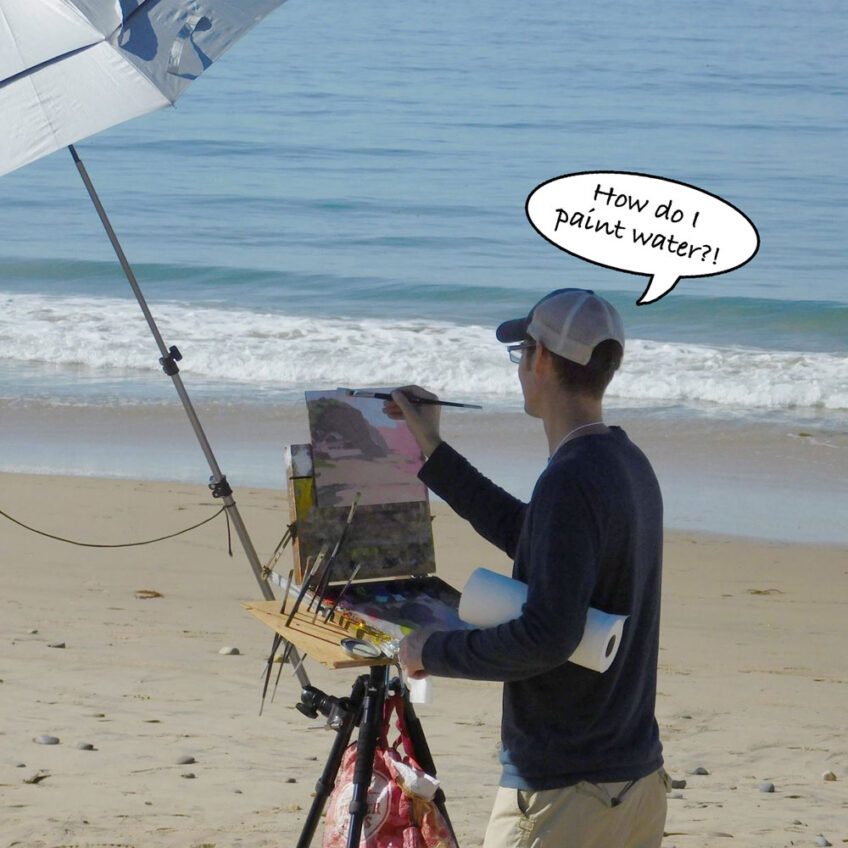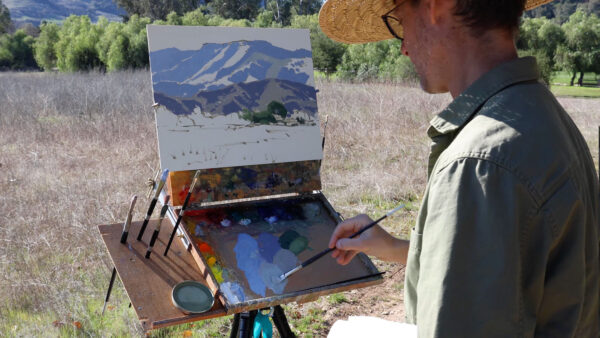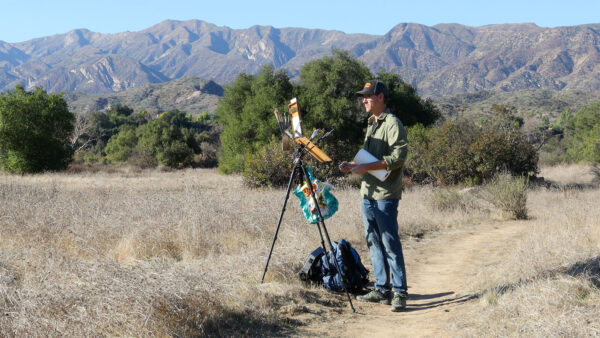Do you ever talk to yourself? I’m here to recommend it.
I don’t mean reminding yourself to put your shoes on. (If that’s you, there may be other blog posts out there better suited to your needs.)
I’m specifically recommending that you talk to yourself about what you’re seeing while you paint. (Hint: it works just as well to THINK to yourself rather than to TALK to yourself. But you’ll miss the odd glances from passers-by in the park where you’re at your easel muttering to yourself with 14 brushes in hand.)
Asking Questions
When we’re painting on location and faced with the task of translating our chosen three-dimensional scene onto our two-dimensional canvas, questions come up.
“How can those distant mountains be blue when I know they’re covered in green trees?”
“How is it that dark pavement can look so bright in the sunlight?”
“That yellow house in the background can’t be painted in such a warm color, can it?” Shouldn’t warm colors only appear in the foreground of my scene?”
Follow the Rules?
Perhaps you noticed that all of those example questions address “rules” we may have been taught about how things are “supposed” to look. I’m a strong advocate for the importance of rules, and they can and do apply much of the time. But I think we as painters ultimately have to learn to trust our eyes.
A familiar quote: “Paint what you SEE, not what you KNOW.” Of course, this requires spending a considerable amount of time practicing the act of painting so that your eyes become trained to see more accurately. As you travel this road of ongoing practice, be mindful that what you THINK you’re seeing isn’t necessarily what you’re ACTUALLY seeing. Our brains like to confuse us that way sometimes. Do whatever you can to make sure you’re accurately judging what you see.
Trick your Brain
One example that I use sometimes with students struggling to properly judge the color of distant mountains: Turn your head sideways while looking at the mountains. This tricks your brain into seeing the mountains in a way it’s not used to seeing them. You might find that they look much cooler in color temperature than you thought they did with your head level. They might look like a totally different color since your brain isn’t confusing you with what it thinks it knows. (Note: don’t do this while driving.)
So, back to my recommendation to talk to yourself: While painting, stop and ask yourself questions about what you see. Do some analyzing, then answer the questions. Don’t just mindlessly carry on painting. Stop to figure out WHY what you’re seeing looks the way it does. If you find yourself relying on a “rule” you’ve learned, stop to consider what your eyes are actually seeing. Then decide whether the rule applies or if your eyes are seeing something contrary to the rule.
Your family and friends will probably still accept you once they discover how much you talk to yourself. If not, turn your head and look at them sideways. Then they will really think you’ve lost it.



17 Responses
Bobbi Dunlop
Always such great advice, Dan! I so enjoy your blog! Bobbi
Karen
That’s what I do. Just so you know, the more intelligent you are, the more you talk to yourself. You are not strange. You are thinking. Yeah
Stephanie Merchant
Love your wisdom and humor! Thanks for sharing!
Laura Brooks
BIG SMILE👍 Right on!!
Love. Love love painting outdoors mixed
With a little humor and very much affordable
Eccentric little quirky moments.
Tracy
As always love your take on things, your humor and encouragement to follow the rules when they apply but follow our instincts when they don’t! Thanks For helping us know the difference Dan!
Nancy Currey
Thank you for the tips! Always helpful.
Jean Myers
Thanks Dan – I will turn my head sideways while asking myself questions 🙂 I need to question more and not plunge ahead so much!
Ed
Thanks Dan, I appreciate your advice, good stuff as usual!
Rashaun
Great advice Thanks!
(big) Ian
It was going okay until the portrait I’m painting answered me!
Dan Schultz
Haha I didn’t think about that possibility!
Debbie Mattison
I’m one of those who just keeps on painting. Maybe if I talk to myself I will slow down and figure it out first. Let’s hope!
Marge Henderson
Fun post as well as informational!
Just told Keith that you didn’t show a picture with your “not a robot” as he was saying he hated those just this week!
Laurie Schultz
Hi Dan,
Oddly enough, if I’m painting from a photograph, I turn the photo upside down, and check for color accuracy, or when I used to draw portraits, turn the drawing upside down to look at the features and how close they resemble the actual face in the photo. Fooling your brain is one of the best skills! The longer you’ve been alive the more your brain assumes it knows how you process the features of a face, or a scene. Nice to know that I’m not crazy, just a little touched, ha ha!
Dan Schultz
Or maybe we’re both crazy! 🙂
Doug Singletary
Thanks Dan, great advice!
Patti Vincent
Looking forward to trying that sideways head tilt trick! Thanks Dan